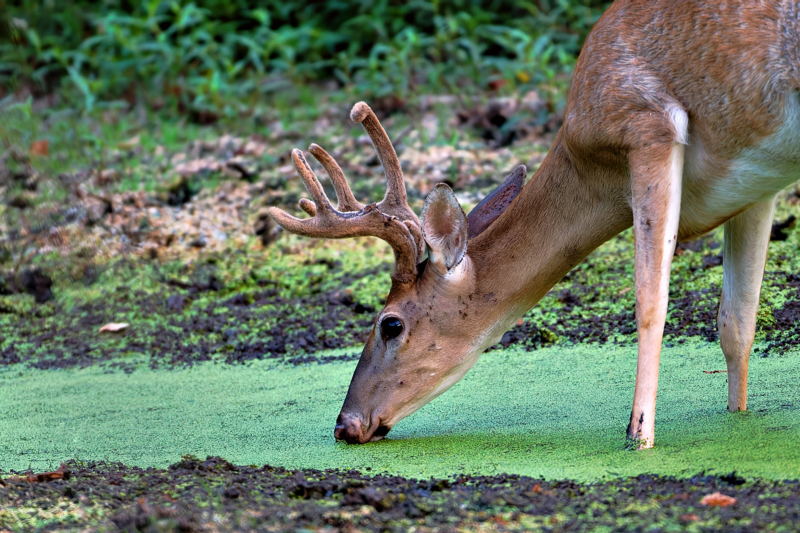Imagine yourself in the heart of nature, capturing breathtaking moments through the lens of your camera. As I stood there, focusing on a magnificent Whitetail Buck, I couldn’t help but ponder its behavior. Was it munching on the lush green duckweed or merely quenching its thirst from the water adorned with this tiny floating plant?

The Dietary Habits of Whitetail Bucks
Deer, including Whitetail Bucks, are known to consume a wide variety of vegetation, ranging from grasses and leaves to fruits and acorns. Duckweed, although not a preferred food source, can serve as a vital alternative when other food options are scarce. These graceful creatures have adapted to survive and thrive in various environments, utilizing whatever sustenance nature provides.
The Ubiquitous Duckweed
Duckweed, a minuscule floating plant that blankets the surfaces of still waters, is often regarded as a bothersome pest due to its rapid proliferation and the potential it has to obstruct waterways. However, this unassuming plant holds far more significance in the ecosystem than one might expect. Duckweed serves as a crucial food source for numerous wildlife species, including the Whitetail Buck.
A Captivating Encounter
The photograph I share with you was taken at the Miner’s Cove of the Sequoyah National Wildlife Refuge in scenic Oklahoma. I had the privilege of observing this magnificent Whitetail Buck from the comfort of my pickup truck, parked on the auto tour road. With my camera and lens positioned on a bean bag resting on the open window, I captured the essence of this incredible wildlife moment.
An Unexpected Hero
While duckweed might be considered a nuisance by some, its impact on the ecosystem extends beyond mere inconvenience. This humble aquatic plant acts as a vital link in the intricate food chain, supporting the survival of diverse wildlife species. Let’s explore the significant role duckweed plays in the lives of Whitetail Bucks and other creatures that depend on it for sustenance.
Rich Nutritional Value
Despite its unassuming appearance, duckweed packs a powerful nutritional punch. It is rich in protein, vitamins, and minerals, providing essential sustenance for herbivorous wildlife. Whitetail Bucks, with their discerning dietary preferences, recognize the value of this floating treasure trove, consuming duckweed when alternative food sources are scarce or inaccessible.
Diverse Wildlife Beneficiaries
While Whitetail Bucks rely on duckweed to meet their nutritional needs, they are not the only beneficiaries of this aquatic plant’s abundance. Ducks, geese, and various waterfowl species also depend on duckweed as a crucial component of their diets. The presence of duckweed in wetland environments promotes biodiversity, attracting an array of water-dwelling organisms, from insects to amphibians.
FAQs: Unlocking the Mysteries of the Whitetail Buck and Duckweed
1. Can Whitetail Bucks survive solely on duckweed?
No, Whitetail Bucks cannot thrive on duckweed alone. While they can consume duckweed when other food sources are scarce, they require a more varied diet to meet their nutritional requirements adequately.
2. Is duckweed harmful to the ecosystem?
Although duckweed can cause challenges by clogging waterways, it also plays a vital role in the ecosystem. As a significant food source for various wildlife species, duckweed contributes to the balance and biodiversity of wetland habitats.
3. What are the preferred food sources of Whitetail Bucks?
Whitetail Bucks have a diverse diet that includes grasses, leaves, fruits, and acorns. They are opportunistic feeders, adapting their preferences based on the availability of food in their environment.
4. Can duckweed be controlled to prevent excessive growth?
Yes, the growth of duckweed can be controlled through various methods such as mechanical removal, chemical treatments, and the introduction of biological controls. Proper management helps maintain the balance between its benefits and potential nuisances.
5. How does duckweed benefit other wildlife?
Duckweed serves as a vital food source for numerous wildlife species, including ducks, geese, and other waterfowl. Its presence in wetland habitats attracts a diverse array of organisms, fostering a healthy and thriving ecosystem.
6. Are there any other plants with a similar ecological role to duckweed?
While duckweed is unique in its floating nature, other aquatic plants, such as water lilies and water hyacinths, also contribute to the ecosystem by providing food and shelter for various wildlife species.
Conclusion: Harmony in Nature’s Tapestry
In the intricate tapestry of nature, the Whitetail Buck and duckweed share a captivating relationship. While the Buck grazes upon the nutritious duckweed when needed, this unassuming plant sustains not only the Buck but also a multitude of other wildlife species. The delicate balance of the ecosystem relies on the interconnectedness of its inhabitants, highlighting the importance of preserving and appreciating the natural world.
As we reflect on this extraordinary encounter between the Whitetail Buck and duckweed, let us embrace the wonders of wildlife photography and strive to protect and cherish the delicate harmony that exists in the wilderness.
